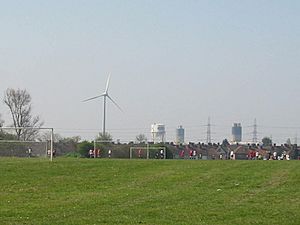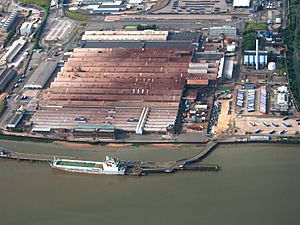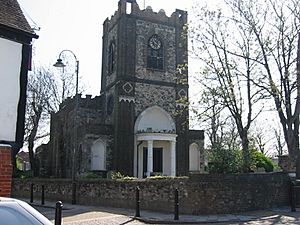Dagenham facts for kids
Quick facts for kids Dagenham |
|
|---|---|
 The southern Dagenham skyline includes structures of the Ford plant and wind turbines. |
|
| Population | 106,247 (2011) |
| OS grid reference | TQ485845 |
| • Charing Cross | 11.5 mi (18.5 km) W |
| London borough | |
| Ceremonial county | Greater London |
| Region | |
| Country | England |
| Sovereign state | United Kingdom |
| Post town | DAGENHAM |
| Postcode district | RM8-RM10 |
| Post town | BARKING |
| Postcode district | IG11 |
| Dialling code | 020 |
| Police | Metropolitan |
| Fire | London |
| Ambulance | London |
| EU Parliament | London |
| UK Parliament |
|
| London Assembly | |
Dagenham (/ˈdæɡənəm/) is a town in East London, England, within the London Borough of Barking and Dagenham. Dagenham is centred 11.5 miles (18.5 km) east of Charing Cross.
It was historically a rural parish in the Becontree Hundred of Essex, stretching from Hainault Forest in the north to the River Thames in the south. Dagenham remained mostly undeveloped until 1921, when the London County Council began construction of the large Becontree housing estate. The population significantly increased as people moved to the new housing in the early 20th century, with the parish of Dagenham becoming Dagenham Urban District in 1926 and the Municipal Borough of Dagenham in 1938. In 1965 Dagenham became part of Greater London when most of the historic parish become part of the London Borough of Barking and Dagenham.
Dagenham was chosen as a location for industrial activity and is perhaps most famous for being the location of the Ford Dagenham motor car plant where the Ford sewing machinists strike of 1968 took place. Following the decline of industry, the southern part of Dagenham adjacent to the River Thames forms part of the London Riverside section of the Thames Gateway redevelopment area, with a new district of Beam Park under construction on the former site of Ford Dagenham.
Contents
History
| 1881 | 3,411 |
|---|---|
| 1891 | 4,324 |
| 1901 | 6,091 |
| 1911 | 7,930 |
| 1921 | 9,127 |
| 1931 | 89,362 |
| 1941 | # |
| 1951 | 114,568 |
| 1961 | 108,368 |
| # no census was held due to war | |
| source: UK census | |
Toponomy
Dagenham first appeared in a document (as Dæccanhaam) in a charter of Barking Abbey dating from 666 AD. The name almost certainly originated with a small farmstead, the "ham" or farm of a man called Daecca, as Dæccan hamm in Old English means home of a man called Dæcca.
Economic development
In 1931 the Ford Motor Company relocated from Trafford Park in Manchester, to a plant in Dagenham, which was already the location of supplier Briggs Motor Bodies. A 500-acre (2 km²) riverside site was developed to become Europe's largest car plant, a vast vertically integrated site with its own blast furnaces and power station, importing iron ore and exporting finished vehicles. By the 1950s Ford had taken over Briggs at Dagenham and its other sites at Doncaster, Southampton, Croydon and Romford. At its peak the Dagenham plant had 4 million square feet (371600 m²) of floor space and employed 40,000.
On 20 February 2002, full production was discontinued due to overcapacity in Europe and the relative difficulty of upgrading the 60-year-old site compared with other European sites such as Almussafes (Valencia, Spain) and Cologne. Other factors leading to the closure of the Auto-assembly line were the need of the site for the new Diesel Centre of Excellence, which produces half of Ford's Diesel Engines worldwide, and the UK employment laws when compared to Spanish, German and Belgian laws. In 2005 Cummins went into a joint venture and offered $15 million (US) to reinstate the factory. Ford and Cummins offered a good redundancy package, billed as one of the best in UK manufacturing. It is the location of the Dagenham wind turbines. Some 4,000 people now work at the Ford plant. The movie Made in Dagenham (2010) is a dramatisation of the 1968 Ford sewing machinists strike at the plant, when female workers walked out in protest against sexual discrimination and unequal pay.
Sterling Ltd who were famous for manufacturing British Army weapons and Jaguar car parts were also based in Dagenham until they went bankrupt in 1988. Other industrial names once known worldwide were Ever Ready, whose batteries could be found in shops throughout the Commonwealth, Bergers Paint and the chemical firm of May and Baker who in 1935 revolutionized the production of antibiotics with their synthetic sulfa-drug known as M&B 693. The May & Baker plant, owned and run by Sanofi-Aventis, occupies a 108-acre site in Rainham Road South, near Dagenham East tube station. It was abandoned in 2013 when the company closed this plant. The council has decided how to use the vacant site. They will redevelop it with a new shopping centre: stores announced so far are a Sainsbury's supermarket and a pub restaurant. More stores will be announced in the future.
Local government
Dagenham was an ancient, and later civil, parish in the Becontree hundred of Essex. The Metropolitan Police District was extended in 1840 to include Dagenham. The parish formed part of the Romford Rural District from 1894. Dagenham Parish Council offices were located on Bull Street.
The expansion of the Greater London conurbation into the area caused the review of local government structures, and it was suggested in 1920 that the Dagenham parish should be abolished and its area divided between Ilford Urban District and Barking Town Urban District. Separately, the London County Council proposed that its area of responsibility should be expanded beyond the County of London to cover the area. Instead, in 1926 the Dagenham parish was removed from the Romford Rural District and designated as an urban district. In 1938, in further recognition of its development, Dagenham became a municipal borough. In 1965 the Municipal Borough of Dagenham was abolished and its former area became part of the London Borough of Barking, which is now known as Barking and Dagenham.
Market gardens to suburban estate
In 1205 Dagenham was large enough to have a chaplain, and the Parish Church of St Peter and St Paul was probably built at around that time. In 1854, the London, Tilbury and Southend Railway was built through the south of Dagenham, near the River Thames. In 1885 a new direct route from Barking to Pitsea, via Upminster, was built with Dagenham station opened just north of the village. Dagenham Dock station opened on the original southern route in 1908. Dagenham was still an undeveloped village, when building of the vast Becontree estate by the London County Council began in the early 1920s. The building of the enormous council estate, which also spread into the neighbouring parishes of Ilford and Barking, caused a rapid increase in population. In 1932 the electrified District line of the London Underground was extended to Upminster through Dagenham with stations opened as Dagenham and Heathway and today called Dagenham East and Dagenham Heathway. Dagenham East was the location of the Dagenham East rail crash in 1958. Services on the London Tilbury & Southend line at Dagenham East were withdrawn in 1962.
Governance
The 2010 wards of Eastbrook, Heath, River, Village and Whalebone are in the Dagenham and Rainham Parliamentary Constituency. The 2010 wards of Alibon, Mayesbrook, Parsloes, Thames and Valence are in the Barking Parliamentary Constituency. Each ward in B&D elects two or three councillors to Barking and Dagenham London Borough Council. The whole area is within the City and East London Assembly Constituency.
Geography

Dagenham is located approximately 11.5 miles (18.5 km) east of Charing Cross in Central London. A large part of Dagenham is within the Becontree estate; however, the area also includes Becontree Heath, part of Rush Green, Old Dagenham village, and the southern section around Dagenham Dock and adjacent to the River Thames. This southern section, which includes Ford Dagenham, is part of the London Riverside section of the Thames Gateway redevelopment zone. The Dagenham post town includes the whole of the Becontree estate, including those sections that were constructed in Barking and Ilford.
Demography
Dagenham is a working class area. During the 2000s there was a large influx of migrants, in particular Africans. The current population of the former (pre 1965) Borough of Dagenham could be approximated from the population of the current wards which together most closely match the area, but the former boundary between the borough and neighbouring Barking, with which it merged in 1965, no longer corresponds to any ward boundaries.
At the time of the 2011 census, the Alibon ward (north of Heathway station) was 61% White British and 15% Black African. Goresbrook ward (southwest from Heathway) was 57% White British and 17% Black African. River ward (south of Heathway) was 51% White British and 19% Black African. Village ward (east from Heathway) was 58% White British and 19% Black African. Eastbrook ward (around Eastbrookend Country) was 69% White British and 11% Black African. Heath ward (north of Heathway) was 60% White British and 17% Black African.
Economy
The former May and Baker plant site at Dagenham East is now a centre of film and television production.
Transport
Dagenham is connected to the London Underground services from three stations, Becontree (in the pre-1965 borough of Barking), Dagenham East and Dagenham Heathway, all on the District line. c2c, part of National Rail operated by Trenitalia since February 2017, runs a train service through Dagenham Dock station. Elizabeth Line services also operate from nearby Chadwell Heath station.
A proposed, and as yet unfunded Docklands Light Railway extension from Gallions Reach to Dagenham Dock. It was anticipated that the project could be completed and open for use by 2017. However the public inquiry has been postponed due to concerns about funding.
Dagenham Heathway is served by the following Transport for London contracted routes: London Buses routes 145, 173, 174, 175 and 364. Routes 145, 173, 174, 175, 287, and EL2 operate in the Dagenham Dock area. Routes 103, 145, and 364 operate in Dagenham East.
Bus routes 5, 103, 128, 150, 173, 175, 499, and N15, and East London Transit service EL2 operate from Becontree Heath, north of Dagenham. Routes 128 and EL1 run a 24-hour service, while the N15 runs through the night.
Culture
Valence House, in Becontree Avenue, is the only surviving of the five manor houses of Dagenham. Dating back to the 13th century, it is sited in parkland and there is a moat around part of it. Valence House is the London Borough of Barking & Dagenham's local history museum, displaying artifacts and archives that tell the story of the lives of the people of Barking and Dagenham. The collection also includes portraits, family papers and other mementos of the Fanshawe family, who occupied Parsloes Manor, since demolished, from the sixteenth century. The Fanshawe collection is "one of the best collections of gentry portraits in the country and is of international importance", according to Valence House. Among members of the Fanshawe family was the diplomat Sir Richard Fanshawe, 1st Baronet, whose portrait is at Valence House. Nine successive members of the Fanshawe family served as Remembrancer to the Crown, following Henry Fanshawe's appointment to the position by Queen Elizabeth I in 1566. The appointment made possible the family's rise to prominence.
In the post town of Romford and the pre-1965 borough of Dagenham, on the corner of Whalebone Lane and the Eastern Avenue, diagonally opposite the Moby-Dick public house, is the site of Marks Manor House, a large 15th-century moated building demolished in the early 19th century. During World War II the adjoining fields were used by the Royal Artillery for an anti-aircraft battery; later a prisoner-of-war camp for Germans was erected there. Further south down Whalebone Lane on the corner of the High Road is the Tollgate pub. This stands on the site of the milestone which marked the ten miles (16 km) limit from the City of London and the turnpike toll-gate.
The Roundhouse public house on the junction of Porters Avenue and Lodge Avenue (in the pre-1965 borough of Barking) became eastern Greater London's premier rock-music venue between 1969 and 1975, incorporating the Village Blues Club. Notable performers at the pub included Jethro Tull, Supertramp, Queen, Pink Floyd, Eric Clapton, Status Quo, and Led Zeppelin (on 5 April 1969). The Eastbrook is a Grade II* listed pub. Given the influence of U.S. blues on the English musicians who played at the Roundhouse, journalist Nik Cohn called the London of the late 1960s and early 1970s the "Dagenham Delta".
Media
The Barking & Dagenham Post is printed weekly and also published online.
Sport
Dagenham & Redbridge F.C., based at Victoria Road were relegated to the National League in the 2015–16 season from the Football League Two, after being relegated from the Football League One which they had reached having been promoted as playoff-winners of League two after beating Rotherham United F.C. 3–2, in the 2010–11 season. They were also the Nationwide Conference champions of the 2006–07 season.
Motorcycle speedway was staged at the greyhound stadium in Ripple Road in the mid to late 1930s. The club run events focussed on training but a team called the Dagenham Daggers did take part in local competitions. It is possible that the venture was operational as early as 1931 a meeting at Caxton (Cambridgeshire) was advertised as Caxton Speedway v Dagenham Speedway.
Dagenham's leading cricket club Goresbrook Cricket Club are based at the May & Baker Sports Club in Rainham Road South, in 2011 the club won the Essex County Cricket League for the first time in its history.
Dagenham has a King George's Field in memorial to King George V. The park was renamed in 1953 by Queen Elizabeth II. Dagenham also has many other parks such as Valence - and Parsloes (which lies partly in the pre-1965 borough of Barking). Dagenham Crusaders Drum and Bugle Corps, founded by John Johnson, was the first British Drum Corps and performed in the United States for the first time in 1983. In 2010 they reformed to perform for DCUK's 30th anniversary, fielding a competitive corps for the first time in 22 years.
Notable people
Please see 'Geography' above for various definitions of 'Dagenham'.
- Actress Adelayo Adedayo was raised in Dagenham.
- Abraham Blackborne, long-serving vicars of Dagenham.
- England international footballer and World Cup-winning manager Alf Ramsey was born in Dagenham in 1920.
- St Peter and St Paul's Church, Dagenham Parish Church, was once the Parish Church of the former archbishop of Canterbury, George Carey.
- Musician and comedian Dudley Moore was brought up in Dagenham, which was the home of Peter Cook and Dudley Moore's famous comic alter-egos Pete and Dud.
- Sandie Shaw, a 1960s pop singer who had a string of hit singles in the decade and won the Eurovision Song Contest in 1967 with Puppet on a String, was born in Dagenham.
- Arsenal and England footballer Tony Adams grew up in Dagenham, attending both Hunters Hall Primary School and Eastbrook Comprehensive School.
- Rap artist Devlin was born in Bermondsey but grew up in Dagenham.
- Australian singer John Farnham was born in Dagenham, before migrating at the age of 10.
- Former darts player Wayne Mardle was born in Dagenham before living in Romford.
- British singer, TV presenter, and personality Stacey Solomon is from Dagenham.
- British singer, Steve Ignorant of the original anarcho-punk collective Crass grew up in Dagenham.
- Richard Wisker actor, was born in Dagenham.
- Chris Youlden blues singer, Savoy Brown, was born in Dagenham.
See also
 In Spanish: Dagenham para niños
In Spanish: Dagenham para niños




